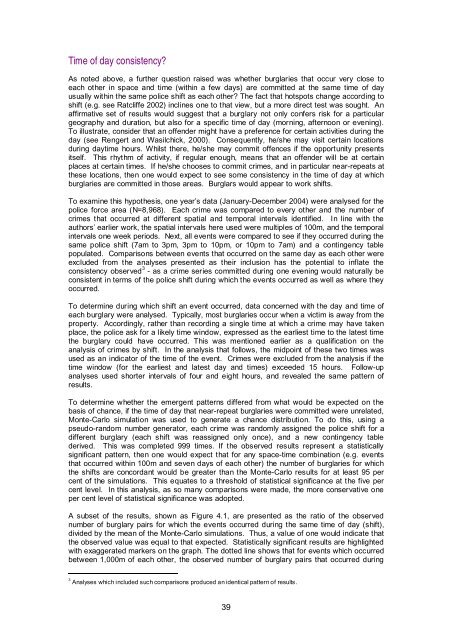Prospective crime mapping in operational context Final report
Prospective crime mapping in operational context Final report
Prospective crime mapping in operational context Final report
- No tags were found...
You also want an ePaper? Increase the reach of your titles
YUMPU automatically turns print PDFs into web optimized ePapers that Google loves.
Time of day consistency?As noted above, a further question raised was whether burglaries that occur very close toeach other <strong>in</strong> space and time (with<strong>in</strong> a few days) are committed at the same time of dayusually with<strong>in</strong> the same police shift as each other? The fact that hotspots change accord<strong>in</strong>g toshift (e.g. see Ratcliffe 2002) <strong>in</strong>cl<strong>in</strong>es one to that view, but a more direct test was sought. Anaffirmative set of results would suggest that a burglary not only confers risk for a particulargeography and duration, but also for a specific time of day (morn<strong>in</strong>g, afternoon or even<strong>in</strong>g).To illustrate, consider that an offender might have a preference for certa<strong>in</strong> activities dur<strong>in</strong>g theday (see Rengert and Wasilchick, 2000). Consequently, he/she may visit certa<strong>in</strong> locationsdur<strong>in</strong>g daytime hours. Whilst there, he/she may commit offences if the opportunity presentsitself. This rhythm of activity, if regular enough, means that an offender will be at certa<strong>in</strong>places at certa<strong>in</strong> times. If he/she chooses to commit <strong>crime</strong>s, and <strong>in</strong> particular near-repeats atthese locations, then one would expect to see some consistency <strong>in</strong> the time of day at whichburglaries are committed <strong>in</strong> those areas. Burglars would appear to work shifts.To exam<strong>in</strong>e this hypothesis, one year’s data (January-December 2004) were analysed for thepolice force area (N=8,968). Each <strong>crime</strong> was compared to every other and the number of<strong>crime</strong>s that occurred at different spatial and temporal <strong>in</strong>tervals identified. In l<strong>in</strong>e with theauthors’ earlier work, the spatial <strong>in</strong>tervals here used were multiples of 100m, and the temporal<strong>in</strong>tervals one week periods. Next, all events were compared to see if they occurred dur<strong>in</strong>g thesame police shift (7am to 3pm, 3pm to 10pm, or 10pm to 7am) and a cont<strong>in</strong>gency tablepopulated. Comparisons between events that occurred on the same day as each other wereexcluded from the analyses presented as their <strong>in</strong>clusion has the potential to <strong>in</strong>flate theconsistency observed 3 - as a <strong>crime</strong> series committed dur<strong>in</strong>g one even<strong>in</strong>g would naturally beconsistent <strong>in</strong> terms of the police shift dur<strong>in</strong>g which the events occurred as well as where theyoccurred.To determ<strong>in</strong>e dur<strong>in</strong>g which shift an event occurred, data concerned with the day and time ofeach burglary were analysed. Typically, most burglaries occur when a victim is away from theproperty. Accord<strong>in</strong>gly, rather than record<strong>in</strong>g a s<strong>in</strong>gle time at which a <strong>crime</strong> may have takenplace, the police ask for a likely time w<strong>in</strong>dow, expressed as the earliest time to the latest timethe burglary could have occurred. This was mentioned earlier as a qualification on theanalysis of <strong>crime</strong>s by shift. In the analysis that follows, the midpo<strong>in</strong>t of these two times wasused as an <strong>in</strong>dicator of the time of the event. Crimes were excluded from the analysis if thetime w<strong>in</strong>dow (for the earliest and latest day and times) exceeded 15 hours. Follow-upanalyses used shorter <strong>in</strong>tervals of four and eight hours, and revealed the same pattern ofresults.To determ<strong>in</strong>e whether the emergent patterns differed from what would be expected on thebasis of chance, if the time of day that near-repeat burglaries were committed were unrelated,Monte-Carlo simulation was used to generate a chance distribution. To do this, us<strong>in</strong>g apseudo-random number generator, each <strong>crime</strong> was randomly assigned the police shift for adifferent burglary (each shift was reassigned only once), and a new cont<strong>in</strong>gency tablederived. This was completed 999 times. If the observed results represent a statisticallysignificant pattern, then one would expect that for any space-time comb<strong>in</strong>ation (e.g. eventsthat occurred with<strong>in</strong> 100m and seven days of each other) the number of burglaries for whichthe shifts are concordant would be greater than the Monte-Carlo results for at least 95 percent of the simulations. This equates to a threshold of statistical significance at the five percent level. In this analysis, as so many comparisons were made, the more conservative oneper cent level of statistical significance was adopted.A subset of the results, shown as Figure 4.1, are presented as the ratio of the observednumber of burglary pairs for which the events occurred dur<strong>in</strong>g the same time of day (shift),divided by the mean of the Monte-Carlo simulations. Thus, a value of one would <strong>in</strong>dicate thatthe observed value was equal to that expected. Statistically significant results are highlightedwith exaggerated markers on the graph. The dotted l<strong>in</strong>e shows that for events which occurredbetween 1,000m of each other, the observed number of burglary pairs that occurred dur<strong>in</strong>g3 Analyses which <strong>in</strong>cluded such comparisons produced an identical pattern of results.39
















